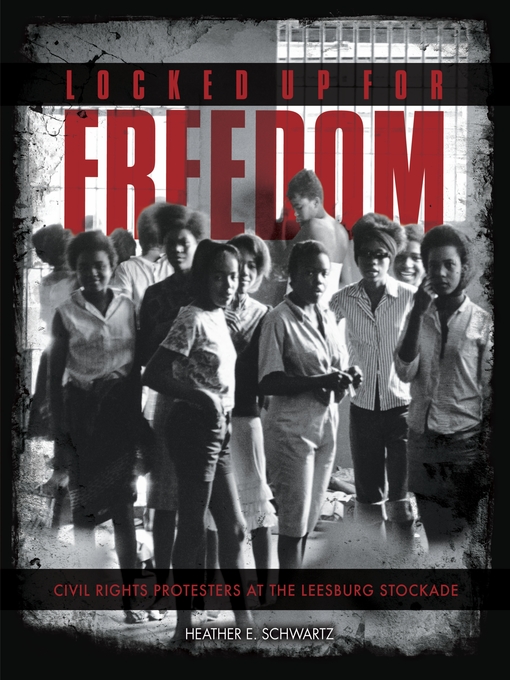-
Creators
-
Publisher
-
Release date
August 1, 2017 -
Formats
-
Kindle Book
-
OverDrive Read
- ISBN: 9781512472424
-
PDF ebook
- ISBN: 9781512428414
- File size: 27265 KB
-
-
Languages
- English
-
Levels
- ATOS Level: 6.6
- Lexile® Measure: 970
- Interest Level: 4-8(MG)
- Text Difficulty: 5-7
-
Reviews
-
School Library Journal
September 1, 2017
Gr 6 Up-In the late summer of 1963, more than 30 African American girls were locked up in an abandoned stockade in Leesburg, GA. They ranged in age from 11-16 years old, and all had participated in some form of protest in relation to the growing civil rights movement. Schwartz dives deep into this particular episode, offering up first-person accounts of the circumstances leading to their imprisonment and the horrific conditions they endured at the stockade. Quotes from interviews and photographs are woven into the narrative, offering details about clogged toilets, bug-infested mattresses, and unhygienic living conditions. Schwartz makes clear that though many young people expected to, and did, go to jail for their participation in marches and protests, this specific situation was unique and particularly heinous because of the conditions and the length of time they were held-not to mention they had no contact with the outside world and their families were not informed of their whereabouts. Introductory chapters provide historical context, thus making this a solid choice for students learning about the civil rights movement. The writing is accessible and the accounts compelling. VERDICT A story that needs to be told. The solid research and concise narrative make it a fine addition to most student-centered collections.-Jody Kopple, Shady Hill School, Cambridge, MA
Copyright 2017 School Library Journal, LLC Used with permission.
-
Kirkus
September 1, 2017
A compelling account of a group of young people who put their freedom and lives at risk as civil rights protesters. In 1963, over 30 African-American girls between the ages of 11 and 16 were arrested for taking part in protests in Americus, Georgia. Unbeknownst to their families, the girls were taken to a Civil War-era stockade in Leesburg, Georgia, where they were confined for weeks in squalid conditions and subjected to inhumane treatment. Schwartz, who interviewed some of the women imprisoned in the stockade, offers a vivid, insightful look at their ordeal. Lack of toilet facilities forced the girls to relieve themselves in their sleeping space, which was nothing more than a stone floor. In addition to overwhelming filth and odor, the stockade was infested with flies, gnats, mosquitoes, and cockroaches. The barely edible food served to them sickened most. They did all they could to support one another and maintain a hopeful spirit, singing freedom songs and praying together. The ordeal makes for gripping reading, but unfortunately it is overwhelmed by the extensive background information on the civil rights movement presented in boxes and on separate pages throughout the account. While the attempt to provide this additional historical context is praiseworthy, it also interrupts the narrative flow and makes it difficult to get a sense of any of the girls as individual characters. A fresh, insightful look at the crucial role young people played in the civil rights movement, though not without its flaws. (photos, timeline, source notes, glossary, bibliography) (Nonfiction. 10-14)COPYRIGHT(2017) Kirkus Reviews, ALL RIGHTS RESERVED.
-
Booklist
September 15, 2017
Grades 5-8 In 1963, a group of teenage girls who had been jailed for their role in civil rights protests were sent to a Civil Warera prison in the heart of Georgia. Crowded into one cell, at least 30 girls between the ages of 11 and 15 served their time in squalid conditions with little to eat or drink, no way to keep clean, and no contact with the outside world. Schwartz utilizes a tremendous trove of primary source material, and recollections from the girls who served time in Leesburg, to make up the bulk of the narrative. Additionally, photographs taken by SNCC photographer Danny Lyon capture the reprehensible conditions and the indomitable spirit of the young inmates. It will be impossible for readers not to feel a sense of relatability with the girls in the photographs, who were so much younger than the more famous heroes of the civil rights era, but no less resolute or brave.(Reprinted with permission of Booklist, copyright 2017, American Library Association.) -
The Horn Book
January 1, 2018
In 1963, thirty African American girls (ages eleven to sixteen) were arrested at a civil rights protest and secretly transported to an abandoned Civil War stockade in Georgia; unable to contact their parents, they endured horrid conditions and treatment. Employing intimate details from survivor interviews and illustrated with stirring photos, Schwartz's clear, powerful narrative will leave an impression on young readers. Reading list, timeline. Bib., glos., ind.(Copyright 2018 by The Horn Book, Incorporated, Boston. All rights reserved.)
-
subjects
Languages
- English
Levels
- ATOS Level:6.6
- Lexile® Measure:970
- Interest Level:4-8(MG)
- Text Difficulty:5-7
Loading
Why is availability limited?
×Availability can change throughout the month based on the library's budget. You can still place a hold on the title, and your hold will be automatically filled as soon as the title is available again.
The Kindle Book format for this title is not supported on:
×- - Kindle 1
- - Kindle 2
- - Kindle 4
- - Kindle 5
- - Kindle 7
- - Kindle DX
- - Kindle Keyboard
- - Kindle Paperwhite
- - Kindle Touch
- - Kindle Voyage
Read-along ebook
×The OverDrive Read format of this ebook has professional narration that plays while you read in your browser. Learn more here.




